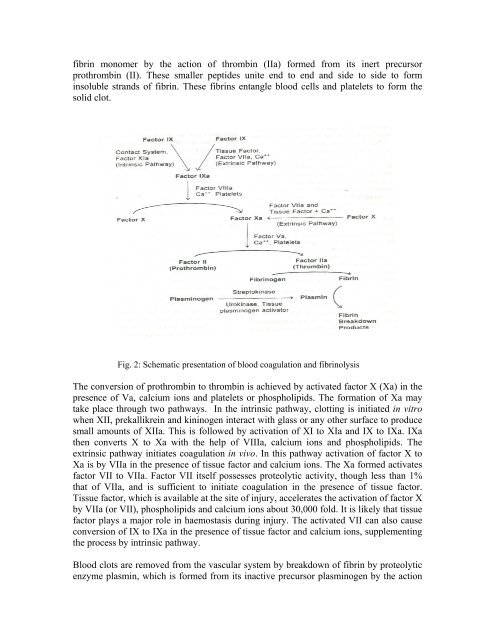MEDICINAL CHEMISTRY
MEDICINAL CHEMISTRY
MEDICINAL CHEMISTRY
You also want an ePaper? Increase the reach of your titles
YUMPU automatically turns print PDFs into web optimized ePapers that Google loves.
fibrin monomer by the action of thrombin (IIa) formed from its inert precursor<br />
prothrombin (II). These smaller peptides unite end to end and side to side to form<br />
insoluble strands of fibrin. These fibrins entangle blood cells and platelets to form the<br />
solid clot.<br />
Fig. 2: Schematic presentation of blood coagulation and fibrinolysis<br />
The conversion of prothrombin to thrombin is achieved by activated factor X (Xa) in the<br />
presence of Va, calcium ions and platelets or phospholipids. The formation of Xa may<br />
take place through two pathways. In the intrinsic pathway, clotting is initiated in vitro<br />
when XII, prekallikrein and kininogen interact with glass or any other surface to produce<br />
small amounts of XIIa. This is followed by activation of XI to XIa and IX to IXa. IXa<br />
then converts X to Xa with the help of VIIIa, calcium ions and phospholipids. The<br />
extrinsic pathway initiates coagulation in vivo. In this pathway activation of factor X to<br />
Xa is by VIIa in the presence of tissue factor and calcium ions. The Xa formed activates<br />
factor VII to VIIa. Factor VII itself possesses proteolytic activity, though less than 1%<br />
that of VIIa, and is sufficient to initiate coagulation in the presence of tissue factor.<br />
Tissue factor, which is available at the site of injury, accelerates the activation of factor X<br />
by VIIa (or VII), phospholipids and calcium ions about 30,000 fold. It is likely that tissue<br />
factor plays a major role in haemostasis during injury. The activated VII can also cause<br />
conversion of IX to IXa in the presence of tissue factor and calcium ions, supplementing<br />
the process by intrinsic pathway.<br />
Blood clots are removed from the vascular system by breakdown of fibrin by proteolytic<br />
enzyme plasmin, which is formed from its inactive precursor plasminogen by the action

















